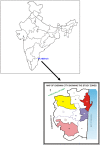Community-based control of Aedes aegypti by adoption of eco-health methods in Chennai City, India
- PMID: 23318241
- PMCID: PMC3541894
- DOI: 10.1179/2047773212Y.0000000056
Community-based control of Aedes aegypti by adoption of eco-health methods in Chennai City, India
Abstract
Background: Dengue is highly endemic in Chennai city, South India, in spite of continuous vector control efforts. This intervention study was aimed at establishing the efficacy as well as the favouring and limiting factors relating to a community-based environmental intervention package to control the dengue vector Aedes aegypti.
Methods: A cluster randomized controlled trial was designed to measure the outcome of a new vector control package and process analysis; different data collection tools were used to determine the performance. Ten randomly selected intervention clusters (neighbourhoods with 100 houses each) were paired with ten control clusters on the basis of ecological/entomological indices and sociological parameters collected during baseline studies. In the intervention clusters, Aedes control was carried out using a community-based environmental management approach like provision of water container covers through community actors, clean-up campaigns, and dissemination of dengue information through schoolchildren. The main outcome measure was reduction in pupal indices (pupae per person index), used as a proxy measure of adult vectors, in the intervention clusters compared to the control clusters.
Results: At baseline, almost half the respondents did not know that dengue is serious but preventable, or that it is transmitted by mosquitoes. The stakeholder analysis showed that dengue vector control is carried out by vertically structured programmes of national, state, and local administrative bodies through fogging and larval control with temephos, without any involvement of community-based organizations, and that vector control efforts were conducted in an isolated and irregular way. The most productive container types for Aedes pupae were cement tanks, drums, and discarded containers. All ten intervention clusters with a total of 1000 houses and 4639 inhabitants received the intervention while the ten control clusters with a total of 1000 houses and 4439 inhabitants received only the routine government services and some of the information education and communication project materials. The follow-up studies showed that there was a substantial increase in dengue understanding in the intervention group with only minor knowledge changes in the control group. Community involvement and the partnership among stakeholders (particularly women's self-help groups) worked well. After 10 months of intervention, the pupae per person index was significantly reduced to 0·004 pupae per person from 1·075 (P = 0·020) in the intervention clusters compared to control clusters. There were also significant reductions in the Stegomyia indices: the house index was reduced to 4·2%, the container index to 1·05%, and the Breteau index to 4·3 from the baseline values of 19·6, 8·91, and 30·8 in the intervention arm.
Conclusion: A community-based approach together with other stakeholders that promoted interventions to prevent dengue vector breeding led to a substantial reduction in dengue vector density.
Figures
References
Publication types
MeSH terms
LinkOut - more resources
Full Text Sources
Medical



